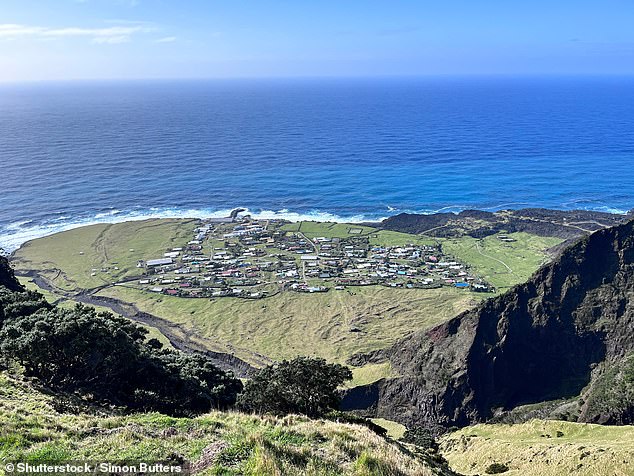There is one police cell and one police officer on the island of Tristan da Cunha.
And that’s just enough.
After all, it’s not like anyone can escape – it’s the world’s most remote inhabited island, 2,787 kilometers (1,732 miles) from the nearest mainland – the southwest coast of South Africa – there are no flights in or out and passenger ships arrive only nine times a year.
Despite the isolation, local Kelly Green tells MailOnline Travel that she loves her life there, revealing that the sense of safety is a definite plus.
She reveals: ‘I’m at work now and my house is unlocked. I’m not afraid that someone will rob me or anything like that. There is a trifle crime but there has never been a murder of Tristan. I don’t think anyone has been locked in the cell since I’ve been here.’
The island’s only police officer is known as the ‘Rockhopper Copper’, a reference to the northern Rockhopper penguins that visit Tristan da Cunha. If there was a serious crime, Kelly says the suspect would have to be transported to St Helena, Tristan Da Cunha’s nearest island neighbor (1,300 miles/2,100 km north).
It’s ‘really not that easy’ to leave the 207 sq km/79 sq mi island, stresses Kelly, who moved to Tristan da Cunha from the UK in 2013.
She continues: ‘The ships (to Cape Town) that we normally go on will only take 12 passengers and only come nine times a year. If you are a family of four and want to leave, it takes up four berths and there may also be expat workers who have to go back.’

Tristan da Cunha is the world’s most remote inhabited island

Kelly Green, who moved to Tristan da Cunha in 2013, told MailOnline what it’s like living on Tristan da Cunha

Tristan da Cunha is 2,787 km/1,732 miles from the nearest part of the continent, South Africa’s south coast
There’s no chance of an airport, but Kelly says: ‘We’re making Tristan a bit more accessible by having more ships.’
Currently, the journey to Cape Town by ship usually takes six days.
The fact that the island is an active volcano that reaches a height of 2,062 m/6,670 ft above sea level adds to the otherworldliness of life there.
And this obviously means that the population lives under a constant threat to their lives.
The last eruption was in 1961 – a micro-second ago in geological time – and meant the entire island had to be evacuated to the UK.
Kelly explains: ‘They’ve been away for a few years and most of them have returned. They didn’t really like England.’
Some more recently born islanders ‘never left’, Kelly reveals, although she ‘does try to get off Tristan every two years’ to visit family and friends in the UK.
The island’s remoteness means Tristan da Cunha’s 236 residents face a long wait for supplies.
Kelly says: ‘We are quite self-sufficient as a farming and fishing community and we grow most of our own meat, eggs and vegetables. But we rely on supplies from Cape Town for things like tea, coffee, sweets, flour and so on. You might be planning to make something or build something, or something goes wrong with your car, and you’ll have to wait a few months for a part. It can be frustrating at times. There is no Amazon Prime.’
Imported goods can also be expensive.

Tristan da Cunha is an active volcano reaching a height of 2,062 m/6,670 ft above sea level

The island’s remoteness means Tristan da Cunha’s 236 residents face a long wait for supplies

Tristan da Cunha is a farming and fishing community and residents grow their own meat, eggs and vegetables

Tristan da Cunha experiences ‘hurricane-force winds’ in winter
Kelly reveals: ‘There are a few subsidized items, but it’s mainly a 75 per cent mark-up if the item is from Cape Town. If we get the item from the UK, it’s a 95 percent markup, so that can make things very expensive. For example, olive oil at the moment is around £10 ($12.64) for quite a small bottle.’
What’s more, since the islanders are mostly self-sufficient, people are not highly paid.
Kelly explains: ‘Even the highest paid jobs are about half of what the minimum wage is in the UK.’
Another challenge is the island’s ‘wild’ weather.
Kelly says that Tristan da Cunha experiences ‘hurricane-force winds in the winter’, with most people living in bungalows as they can withstand the winds more easily.
She adds: ‘Our port is only operational about 70 days of the year.’
But while life on the world’s most remote inhabited island is challenging and unique, many aspects of it are remarkably normal.
Kelly reveals that residents can stream TV shows and movies, drink in a bar and there are a range of job opportunities on offer.
Kelly, who works at the island’s tourism office, explains: ‘We have all kinds of jobs – anything you think a community needs to make it functional. Teachers, nurses, bank staff, carpenters, electricians and plumbers.’
However, there is one difference. Tristan da Cunha’s main source of income is Tristan Rock Lobster, which every islander plays a role in harvesting and processing.
Kelly says: ‘People usually have their government jobs, then they’ll go work in the fish factory or become a fisherman for the day. My husband is a carpenter, but on a fishing day he is a fisherman. I will do my usual day’s work and when the boats come back in the evening I will process fish.’

Kelly explains: ‘There’s not a lot of free time because you get up quite early here, then you go to your government job, then after your government job, you usually look after your animals and potato patches and vegetables.’
So if you think life on a remote island will leave you with endless free time – think again.
Kelly explains: ‘Surprisingly, there’s not a lot of free time because you get up quite early here, then you go to your government job, then to your government job, you usually look after your animals and potato patches and vegetables.’
Not surprisingly, much of the free time that residents do have is spent outside.
Kelly says: ‘A lot of people like to braai (barbecues). There is one pool, so the kids love it in the summer. People also like to go to the beach and we do a lot of walking in the mountains.’
Locals and the tourists who visit by cruise ship also like to spend time on neighboring Nightingale Island (40 km/20 miles from Tristan), Kelly explains.
She says: ‘There is just an abundance of wildlife. Sometimes you can barely move – you climb onto a rock and you’re surrounded by penguins and seals.’
Apart from the wildlife, the volcano is the island’s top attraction.
Kelly says: ‘You can walk up there and it has spectacular views over the settlement.’
And when the weather isn’t good, the residents now have a strong enough internet connection to watch Netflix.
Kelly says: ‘We’re in our second month with Starlink internet (a satellite internet service) so for the first time ever we can watch Netflix. Before, if I wanted to download a game on my phone I would have to leave it overnight, now it’s like a second.’
Although the island doesn’t have a restaurant and Kelly says she ‘really misses eating out’, Tristan da Cunha does have a shop and the bar, The Albatross Bar, is ‘busy with locals at the weekend’ and ‘a lot popular with tourists, who just like to say they could drink a beer there.
The islanders’ favorite tipples? Beer and whiskey, according to bar manager Randall Repetto.
Kelly continues: ‘It’s a very social life because everyone knows everyone.’
Although there are occasional disputes within the ‘close-knit’ community, she explains ‘people get over them very quickly because it’s not like you can avoid anyone’.
Expat workers are the only outsiders living on the island and include the doctors who staff Tristan da Cunha’s one hospital, the Camogli Healthcare Centre.
Kelly says: ‘It’s a very nice, comfortable hospital. It’s quite modern, we don’t have any big CT scans or MRI scans, so the doctors here can really only do kind of minor surgeries like appendicitis, maybe a few hernias. For anything big we have to be transferred to Cape Town.’ A dentist also visits the island once a year and there is a trained local hygienist.
So what’s the best thing about the island’s remote lifestyle?
Kelly says: ‘The best part of Tristan is definitely the freedom you feel here, the safety you feel here and the beauty of the island. It depends on what you like, but I like being close to wildlife and my farm animals. Just knowing that my children are safe and they can just run outside. It’s a nice feeling to have that. I’m sure it’s not for everyone, but it’s definitely one of a kind.’





